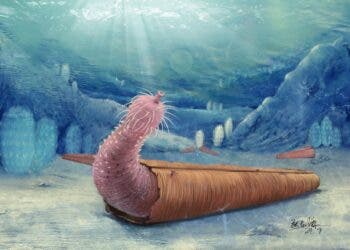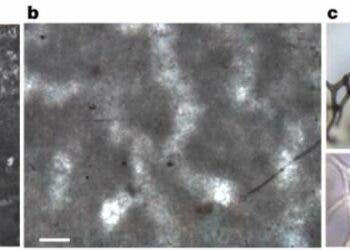
It’s hard to imagine it nowadays, but the Grand Canyon used to be part of an ocean 500 million years ago. In fact, some of its layers contain information from two billion years ago. Tucked inside some of those layers are some outright bizarre creatures; like, for instance, this penis worm.
The new species Kraytdraco spectatus belongs to a group called priapulids, an animal phylum often called “penis worms” because of their tubular, retractable bodies. Researchers named this one in honor of the huge krayt dragons from the Star Wars universe, but that’s not nearly the most interesting thing about it.
A Retractable Throat
The new study describes fossils from the Cambrian period, around 505 million years ago. This was a period that marked a profound change for life on Earth. Before, the majority of life was small and microscopic. During the Cambrian, life started diversifying and becoming more complex. Most of the animal groups we know today emerged during the Cambrian.
The new study describes over 1,500 small carbonaceous fossils, from this period, many remarkably well-preserved. Among them were crustaceans and mollusks, as well as microbial mats and algae. But perhaps most interesting, scientists also described priapulids with filament-covered teeth.
There are over twenty species of penis worms living in today’s oceans, as well as several fossil species known from the geological record. This particular one lived in a shallow, warm, oxygen-rich sea covering what is now Arizona. The seafloor here was lively. This was not a quiet or marginal environment, but rather it was prime ecological real estate with all sorts of animals.
Kraytdraco was probably 1.5 to 4 cm long, though the fossils mostly preserve just its pharynx (feeding organ). Like modern priapulids, it likely had a retractable feeding tube that it could thrust outward and pull back in. It probably spent most of its time buried in sediment, only poking its pharynx out to feed. But when it was feeding time, the creature was ready.
The worm has something akin to a retractible throat. It pushed it outward, inside out, like an inverted glove. Then, on the inside of this throat, were hundreds of specialized teeth. Some of the teeth were stout hooks and prongs, good for scraping and raking detritus. Others were fine, filament-bearing teeth that looked like delicate combs, perfect for sifting and trapping small particles.
This suggests it was a detritus feeder or selective micro-particle feeder, not a predator.
Life in the Cambrian

The Cambrian explosion is probably the most intriguing period for life on Earth. It’s a time when there were still many empty ecological niches on the planet and evolution was “experimenting” all sorts of things. Of course, this isn’t a conscious experimentation in the way a scientist runs trials in a lab. Evolution has no foresight and no plan. It works through variation and selection, triggering countless small genetic changes to arise at random, and those that happen to improve survival or reproduction are passed on. During the Cambrian, there was a lot of empty space for experimentation.
Kraytdraco is an example of that experimentation. But it was also competitive.
Burrows, feeding trails, and resting marks preserved in the sediment show that the seafloor was alive with worms, arthropods, and other invertebrates. The conditions were tough in the sea, but the Grand Canyon fossils show that life wasn’t just about surviving harsh conditions. It was about outcompeting your neighbor. And once that race began, it never stopped. Escalation became a permanent feature of evolution.
In this Cambrian “arms race,” Kraytdraco was a middle-tier consumer. It wasn’t the top predator like the Anomalocaris with 16,000 eyes, but it was an efficient processor of organic material. Its main advantage was its versatility. Kraytdraco wasn’t specialized for one food source. It could rake detritus, trap organic matter, or possibly consume small eukaryotes. That adaptability may have given it an edge in competitive Cambrian seas. Its very existence points to the evolutionary “arms race” already unfolding.

That process explains why later ecosystems grew so complex, why predators became more efficient, why prey evolved defenses, and why energy flowed through increasingly intricate food webs. In short, the arms race you see in today’s oceans — the shark’s teeth, the clam’s shell, the octopus’s camouflage — had roots in the Cambrian shallows of the Grand Canyon.
It’s easy to dismiss ancient worms and crustaceans as curiosities. But they matter because they show when and how the rules of life were set. The same competitive dynamics that shaped your ancestors are still shaping ecosystems today.
The study was published in the journal Science Advances.






